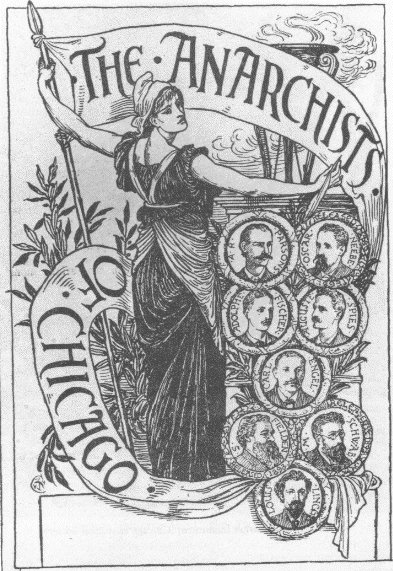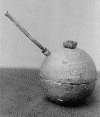
When an anarchist--whose identity remains a mystery even today--tossed a homemade bomb into a great company of Chicago police at 10:20 P.M. on the night of May 4, 1886, he could not have appreciated the far reaching consequences his reckless action would have. His bomb, thrown in a light drizzle as the last speaker at a labor rally climbed down from the speaker's wagon, set off a frenzy of fire from police pistols that would leave eight officers and an unknown number of civilians dead, and scores more injured. It led to the nation's first "Red Scare," refocused national labor and immigration policy, and set the stage for one of the most infamous trials in the history of American jurisprudence. The Haymarket Trial, the cause celebre for American radicals in the 1880s, produced death sentences for seven of Chicago's most prominent labor leaders--convicted more for their words than deeds at a time when the First Amendment provided scant protection against an outraged public.
Background
With the end of the Civil War, a new breed of labor leader emerged--men who urged America now to turn its attention to the "social emancipation" of working people. One of these leaders, Ira Steward of Massachusetts, concluded that the best hope lay in winning for laborers--then plugging away from sunrise to sundown--an eight-hour work day. Across the nation, Steward's followers formed eight-hour leagues and organized rallies and parades in support of their new cause. The issue galvanized the American labor movement, and the number of unions in cities such as Chicago doubled in less than a year. A statewide convention of the Grand Eight-Hour League met in Chicago in 1866 and resolved to push legislation in Illinois that would enact an eight-hour work system. The strategy was successful, and on March 2, 1867, Governor Oglesby signed America's first eight-hour law.
Many Chicago employers, however, chose to fight the eight-hour mandate. They believed the law violated the sacred "liberty of contract": the right of each employer and employee to agree on terms of work free from governmental interference. When the new law took effect on May 1, many large Chicago employers simply refused to comply, demanding that their employees continue to work their customary ten-to-twelve-hour days. Police aided employers in suppressing the resulting worker unrest, and timid politicians from the governor's office down refused to enforce the eight-hour law, rendering the hard-fought legislative victory meaningless. As a dispirited labor movement faded in strength, booming Chicago came to represent as much as any city in the nation the new Gilded Age--a period of excess, when capitalists raked in huge profits with the help of cheap immigrant labor and easily corrupted politicians. City businessman gathered at splendid lakefront clubs, racetracks, or opera houses and discussed rising crime rates or the troublesome politics of the working class.
In the 1870s, following the disastrous fire of 1871, European socialists--most from Germany, Scandinavia, or Bohemia--poured into Chicago. The man who would become the city's most prominent labor agitator came, however, not from Chicago but from Texas. In 1874, Twenty-six-year-old typesetter (and campaigner for the rights of freed slaves) Albert Parsons joined Typographical Union No. 16. He and his black wife, Lucy, settled in a heavily German neighborhood on the city's North Side. There, in a stew of immigrant radicalism, Parsons soon came to believe "there was a great fundamental wrong at work in society." During the depression of the mid-1870s, Parsons began traveling to beer hall back rooms urging laborers to join the new Social Democratic Workingmen's Party.
One member of the North Side's large German community was an idealistic young upholsterer named August Spies. Spies consumed books by philosophers, attended socialist lectures, and joined parades demanding bread or work. In the spring of 1877, Spies, while campaigning among German laborers for the Workingmen's Party, met Albert Parsons, who was then running for City Council.
Labor tensions erupted in Chicago in the summer of 1877. At the Burlington yards, police fired on striking railroad workers and gangs of youths who had started stoning an incoming passenger train. One Burlington switchmen and two youths died in the hail of bullets. Meanwhile, strikers elsewhere in the city idled lumberyards and police battled several hundred cabinetmakers, meeting to discuss the eight-hour question, at Turner Hall on 12th Street. The Turner Hall riot moved August Spies to a new level of militancy--he joined the armed organization of German workingmen called Lehr and Wehr Verein. Parsons found himself fired from his composing job because of his labor activism. Plainclothes police officers took him to police headquarters where Police Superintendent Michael Hickey, flanked by dozens of well-dress businessmen, warned Parsons that if he didn't leave Chicago he might soon find himself assassinated. "Take warning," the superintendent told him as he pushed Parsons into a hallway at the conclusion of a two-hour meeting.
Parsons, however, was not a man to be easily discouraged. In the fall of 1877, he narrowly lost his race for City Council--he felt he was robbed of victory by election official. His words took on a new militancy after his election defeat. He told members of the worker's militia to prepare for battle: "If people try to break up our meetings, as they did at Turner Hall, they will meet foes worthy of their steel." When, a few years later, the Illinois legislature voted to ban worker militias--while at the same time allowing the businessmen's First Regiment to arm and conduct drills on public streets--, Parsons concluded that the Constitution and the courts afforded worker's no protection. They had to protect themselves.
The German-language newspaper, Arbeiter-Zeitung, became the voice of militant socialism in Chicago. Managed by Spies, with the assistance of Oscar Neebe, the Arbeiter-Zeitung, became the most widely circulated and important radical newspaper in America. One of its energetic reporters was a Bavarian bookbinder named Michael Schwab, who wrote on topics such as the devastating impact increased mechanization was having on skilled workers and the destitution he discovered in overcrowded South Side slums. In October 1882, revolutionary hero Johann Most spoke to an enthusiastic crowd of 6,000 immigrant workers at the North Side's Turner Hall. Most's call for direct militant action struck a responsive chord with many in the audience, including Spies and Schwab.
Parsons, meanwhile, had concluded that the eight-hour day provided the key to a better life for workers, and--working through the Knights of Labor--he dedicated himself to building a labor crusade around the issue. He understood that the battle would not be easy, noting that workers would confront "the discharge, black-list and lockout...enforced by the militiamen's bayonet and the policeman's club."
When Chicago fell into another depression in 1884, class consciousness rose to new heights. The Arbeiter-Zeitung, complained that as wealthy businessmen lived opulently, workers suffered and unemployment rose. Even in companies where profits rose sharply, employers cut wages. Strikes became more common--and some led to violence. When members of the state militia shot striking quarry workers in May 1885, anarchists responded with a call to establish both an armed militia and "a school of chemistry," where instructors would teach the manufacture and use of explosives. According to a Chicago Tribune reporter present at the meeting, Lucy Parsons called for "a war of extermination against the rich" and urged taking the battle to "the avenues where the wealthy live." Anger among workers intensified in July when, during a streetcar strike, Police Captain John Bonfield led a clubbing army of 400 officers against crowds attempting to block a line. By the end of 1885, the bloody streets of Chicago seethed with unprecedented anger and suspicion.
The Haymarket Riot
In the early months of 1886, membership in Chicago Internationals (militant unions) swelled to record levels while the Arbeiter-Zeitung, and the anarchist publication the Alarm (edited by the Parsons) unleashed a steady stream of editorials railing against greedy capitalists. At Grief's Hall, an anarchist group (called the American Group) met regularly to sing, share ideas, and debate strategy. Among the American Group's members were the Parsons and the group's most successful recruiter, Samuel Fielden. Toymaker George Engel headed another ultramilitant North Side anarchist group that counted among its members a German printer named Adolph Fischer.
The ultramilitants grew to see dynamite bombs as the great equalizer in the coming war with capitalists. Lucy Parsons called dynamite "the voice of force, the only voice which tyranny has ever been able to understand." Spies handed a newspaper reporter the casing for a dynamite bomb and said, "Take it to your boss and tell him we have 9,000 more like it." Whereas for many anarchists dynamite was merely talk, for carpenter Louis Lingg, it was his passion. Lingg applied his skills toward developing dynamite bombs that might be used to deadly effect.
In the early spring of 1886, labor leaders focused on the eight-hour work day as the means to a better life for working people. Worker unrest rose to unprecedented levels in all sections of the country--a movement so sudden and pervasive that historians would come to give it the label "The Great Upheaval." No place in the nation would play a more pivotal role in the Great Upheaval than Chicago where, on the national eight-hour strike day of May 1, as many as 60,000 workers left their jobs.
Labor organizations around the nation mobilized for "Emancipation Day." Chicago's Eight-Hour Association and the Knights of Labor prepared for the largest strike in city history. Momentum seemed to be working in labor's favor. In Chicago, nearly 50,000 employees won shorter work days without a cut in pay. In April, the Chicago City Council approved an eight-hour day for city workers. When the long-anticipated strike day arrived, business in Chicago came to a virtual halt. May 1 saw celebrating laborers parade with banners and signs through industrial districts and toast each other at West Side saloons. The day ended without violence.
At the same time, however, labor conditions at various plants around Chicago were tense. Nowhere were conditions more combustible than at the McCormick Reaper Works. The Reaper Works' hard-nosed owner, Cyrus McCormack, Jr., ordered a lockout at the factory in response to a union plan to call for a strike. Management hired replacement workers and arranged for an army of 400 police officers to guard the strikebreakers. As the plant reopened, striking workers gathered near the factory to listen to speeches by Albert Parsons and Michael Schwab. During the May 1 strikes, even the nonunion workers were swept up in the enthusiasm, and half left work. Management--in an act of desperation--promised replacement workers an eight-hour day, while refusing to extend the same offer to its original union workers.
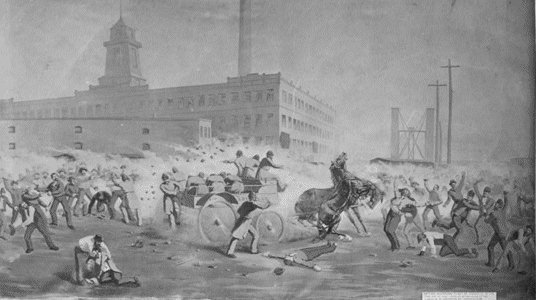
Riot at McCormick's Reaper Works in Chicago (5/3/1886)
Two days later, a violent clash at the Reaper Works pushed events in the direction of an even more violent climax at Haymarket Square. On the afternoon of May 3, as August Spies spoke to several thousand workers near the plant gates, the factory bell sounded, signaling the end of a shift. As if on cue, many of the workers hurried off to heckle the replacement workers leaving the factory. A patrol wagon and 75 police officers rushed in to protect the replacement workers. When some hecklers began to throw rocks, police responded with gunfire, killing at least two strikers.
A furious August Spies wrote and published a leaflet, with the heading "Workingmen to Arms!", giving his version of the incident at the Reaper Works. In a dramatic flourish, the leaflet ended with the words: "To arms we call you, to arms!" On the evening of May 3, about 1,200 copies of the leaflets were distributed by horseback in working neighborhoods. Some of the inflammatory circulars were dropped off that night at Grief's Saloon on West Lake Street, and distributed to a group of German anarchists who had gathered there for a meeting. (Later, prosecutors would attach great significance to the meeting--"the Monday night conspiracy.") A motion was made and adopted to hold a rally at 7:30 the following night. The place would be the Haymarket. Adolf Fischer ordered 25,000 handbills printed in German and English promoting the Haymarket rally. "Good speakers will denounce the latest atrocious act of the police," the handbill promised.
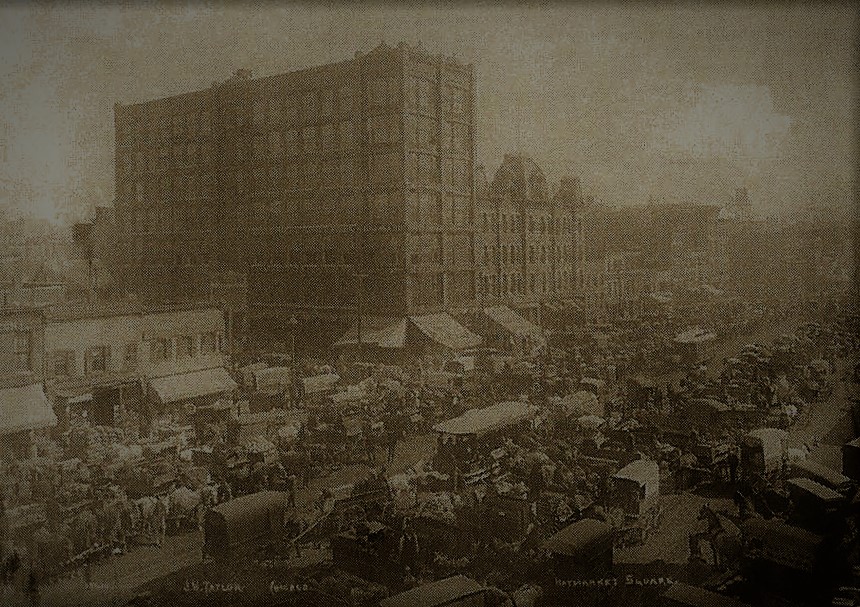
Haymarket Square in the 1890s
Two to three thousand workers--a number that rally promoters found disappointing--gathered at the Haymarket on the night of May 4. August Spies spoke first, telling the crowd that the rally had not "been called for the purpose of inaugurating a riot," but rather to "throw light upon various incidents." About 9:00, Spies introduced the next speaker, Albert Parsons. Parsons' address lasted about an hour, and was generally considered tame, given the circumstances. "I am not here for the purpose of inciting anybody," Parsons told the crowd. The speech did, however, include a statement urging workers, "Americans, as you love liberty and independence, arm, arm yourselves!" As Parsons finished speaking, Mayor Carter Harrison, confident that the rally posed no serious threats to public safety, rode off on his white horse.
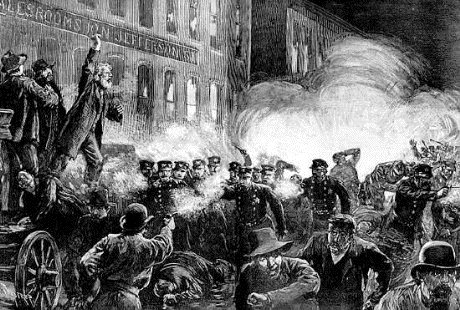
Sketch by Thure de Thulstrup (Harper's Weekly 5/15/1886)
The final speaker for the evening, Samuel Fielden, mounted the speaker's wagon, under threatening skies, about 10:00. With rain apparently imminent, most of the crowd drifted away. Only about 300 persons remained when Fielden launched into the night's most inflammatory rhetoric. Fielden urged the crowd to "lay hands on [the law] and throttle it until it makes its last kick." Two detectives in the crowd rushed off to tell Police Chief Bonfield that the speaker was urging attacks on lawmen, prompting Bonfield to order ranks of his officers to march on the Haymarket and break up the rally. Stopping a few feet from the speaker's wagon, Police Captain William Ward shouted, "I command you, in the name of the people of the state of Illinois, immediately and peaceably to disperse!" Fielden insisted that the gathering was peaceable, but agreed to end the rally: "All right, we will go." At that moment, a sphere whizzed over the audience and landed in the police ranks. The bomb exploded with a deafening roar. Wounded police fell to the ground. Officers began firing into the crowd. Shots continued for two or three minutes, as workers ran in every direction chased by angry police. The Haymarket riot lasted only about five minutes, but it left seven police officers--and an unknown number of civilians--dead. Sixty more officers received serious wounds. There would, everyone seemed to agree, be a heavy price to pay.
The Haymarket Trial
Headlines in Chicago papers cried out for vengeance against the mostly immigrant workers believed to have inspired the Haymarket riot. Typical of the the blood lust was an editorial in the Chicago Times that urged, "Let us whip these slavic wolves back to the European dens from which they issue, or is some way exterminate them." Responding to the public clamor for justice, police (without a warrant) searched the offices of the pro-labor German-language newspaper, the Arbeiter-Zeitung. Schwab and Spies, in the office writing copy for the next issue, were arrested and taken to jail. At the jail, according to Spies, officers "jumped upon us, tore us from one end to the other." Police rounded up Oscar Neebe, the Arbeiter-Zeitung's assistant manager, at his home the next morning. Samuel Fielden, still recovering from a bullet wound to his leg, was picked up on May 6. Police also raided the offices of the Alarm, only to discover that Parsons--taking his wife's advice--had fled Chicago. (Parsons hopped trains to Waukesha, Wisconsin, where he stayed at the home of a socialist friend.) For the next several weeks, civil liberties took a vacation in Chicago as police--usually without warrants--ransacked the homes of known socialists and anarchists, often beating and threatening occupants in the process.
"The Anarchists of Chicago" by Walter Crane
The arrested men claimed to know nothing about the bomb throwing--and condemned the act. Protestations of innocence, however, mattered little to the coroner's jury convened as part of the inquest into the death of officer Mathias Degan, the first officer to die on May 4. The jury concluded that Degan's death was "aided, abetted, and encouraged" by Spies, Schwab, Fielden, and Parsons.
Police continued to search for the bomb thrower. On May 14, they arrested Louis Lingg who had been fingered as an explosives maker and was suspected of having thrown the fatal bomb. Other evidence, however, pointed to an anarchist named Rudolph Schnaubelt, a man who police had interviewed earlier, then released, as the perpetrator of the Haymarket crime.
On May 27, a Chicago grand jury indicted twelve persons in connection with the Haymarket riot. In addition to Lingg and those previously cited by the coroner's jury, the list included George Engel, Oscar Neebe, Adolf Fischer, Rudolph Schnaubelt, and William Seliger. (Schnaubelt fled Chicago and was never tried; Seliger avoided prosecution by turning state's evidence.) The jury's report concluded: "We find that the attack on the police of May 4 was the result of a deliberate conspiracy, the full details of which are now in the possession of the officers of the law." Trial of the Chicago anarchists was set to open on June 21, 1886.
Trial began in the Cook County courtroom of Judge Joseph Gary. Defense lawyer William Black, a former captain in the Union army, represented the eight defendants--or, rather, seven defendants, as Albert Parsons remained in hiding in Wisconsin. Black finally persuaded Lucy Parsons to send word for Albert to return for trial, contending that his fugitive status suggested guilt and complicated his defense of the other defendants. On the opening day of trial, after Judge Gary heard and denied defense motions to hold separate trials for each defendant, Parsons electrified the packed courtroom audience by walking calmly into the courtroom and taking his seat with the other prisoners.
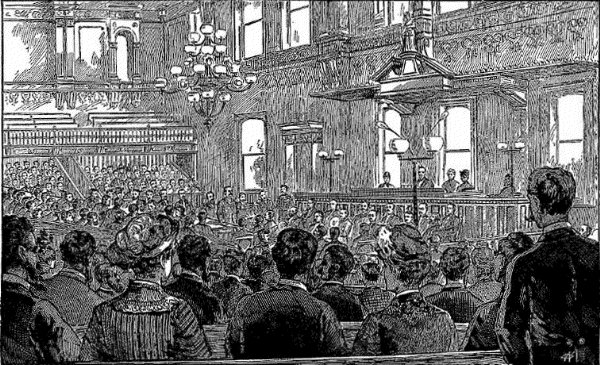
The defendants could not have been pleased with the twelve men chosen as jurors--chosen, it turned out, from a jury pool that had been handpicked by the bailiff, rather than from one randomly selected, as had been the customary practice. None of the jurors selected was an immigrant or laborer or professed radical political beliefs.
Julius Grinnell argued in his opening statement for the prosecution that August Spies was the mastermind of the bomb plot. His speeches, Grinnell claimed, revealed his belief that justice for workers could only be achieved through violence. It was Spies's revenge circular that incited the bomb throwing at the Haymarket, Grinnell contended. Grinnell also suggested that the Grief's Hall meeting on May 3, attended by George Engel and other anarchists, authorized the use of bombs at the Haymarket and that Engel had contacted Lingg about providing explosives that he hoped would start a citywide workers' uprising. Grinnell conceded that the actual bomb thrower was not in court, but told jurors not to let that deter them from conviction: "The question for you to determine is, having ascertained that a murder was committed, not only who did it, but who is responsible for it, who abetted it, assisted it, or encouraged it?"

Prosecutor Julius S. Grinnell
Labor leader Gottfried Waller, who chaired the May 3 meeting of anarchists at Grief's Hall, turned state's evidence and provided details about the decision to hold a rally at the Haymarket. Waller, however, denied that dynamite was ever discussed at the meeting. We anticipated no police intervention, he said, so the topic never came up.
The most damning prosecution testimony came from two witnesses who tied Schwab and Spies directly to the bombing. M. M. Thompson claimed to have overheard Schwab and Spies discussing how to respond to the overwhelming police presence at the rally. According to Thompson, Spies asked Schwab, "Do you think one is enough or hadn't we better get more?" Thompson assumed the men were talking about the number of bombs needed. Thompson also testified that he saw the Spies and Schwab talking later with a man he identified from a photograph as Schnaubelt, the man widely assumed at the time to have been the actual bomber. The second witness, H. L. Gilmer, offered even more sensational testimony, though his credibility more in question. Gilmer, when asked whether he could identify the man who lit the bomb, pointed his hand directly at Spies and said, "There is the man." Spectators in the hot courtroom erupted in excitement with this pronouncement, causing Judge Gary to hammer his gavel for several minutes in an attempt to quiet the crowd.
Much of the prosecution case, however, was less dramatic. Prosecutors bored jurors and spectators by introducing so many radical newspapers and pamphlets that they filled exhibit tables and spilled on to the courtroom floor. The most interesting of the documents was a handwritten note (apparently in the hand of Spies) with the German word "Ruhe." Prosecutors alleged that the word "ruhe" was to be, when published in the letter column of the Arbeiter-Zeitung, a signal to militant labor activists to take violent action against authorities. In addition to the documentary evidence, prosecutors also presented nervous jurors with a collection of bombshells, dynamite, and fuses.
Mayor Carter Harrison testified as the star witness for the defense. The mayor told jurors that the Haymarket gathering was peaceable and that he saw no evidence of weapons among those in attendance. He testified that he told Police Chief Bonfield that he should send his reserves home, as no violence seemed likely to occur. Mayor Harrison's testimony was supported by several other defense eyewitnesses.

The defense called witnesses to contradict prosecution testimony tying Schwab and Spies to the bomb throwing. Witnesses testified that the bomb came from a position far removed from the speaker's wagon, and the Spies at the time was in no position where he could have handed a lighted bomb to the alleged thrower. Witnesses also testified that all the shots they saw fired after the bomb came from the police, suggesting strongly that most police casualties came from "friendly fire."
On August 7, the defendants themselves began parading to the witness stand. Samuel Fielden offered jurors a sample of the speech he gave at the rally--delivered so eloquently that writers suggested he could make a handsome living on the lecture circuit. August Spies conceded that he wrote the circular announcing the Haymarket rally, but said that he had directed that the words calling workers to arms be removed-- as they were from many of the later-published leaflets. Spies testified that he remained on the speaker's wagon the entire time and was as shocked as anyone when the bomb exploded.
In his summation for the defense, Sigmund Ziesler blamed police--and especially Inspector Bonfield--for the Haymarket tragedy: "These men were not heroes, but knaves, led on by the most cowardly knave who ever held public position." Ziesler argued that Bonfield's decision to send 180 heavily armed police officers to break up a peaceable and constitutionally protected rally led to the deaths of his officers. He also told jurors that the prosecution's central argument, that the defendants conspired to start a workers' revolution on May 4, was "ridiculous" on its face.
Defense attorney William Foster picked up where Ziesler left off. Foster argued that Spies had no knowledge of the alleged significance of the word "ruhe," when it appeared in his newspaper. He also insisted that Albert Parsons would never have brought his wife and children to the Haymarket if he had any idea that violence was likely to erupt there. Foster admitted that Lingg was in fact a bomb maker, but argued that no testimony linked his bombs to the one thrown at the Haymarket. Oscar Neebe, Foster claimed, sat at the defense table for no reason other than having left a few copies of the Haymarket circular at a bar and having weapons in his house. The decision to prosecute on such weak evidence, Foster told jurors, showed that the prosecution case was based largely on passion and prejudice. He told jurors to remember their sworn duty to apply the law without prejudice and not to do something that will "haunt you to the grave." Foster concluded by calling the prosecution "a farce."
The final argument for the defense came from William Black. Black told jurors that the testimony of the prosecution's two eyewitnesses, Thompson and Gilmer, had been thoroughly discredited and that the entire prosecution case rested on the slimmest of circumstantial evidence. He noted that six of the defendants were not in the Haymarket at the time the bomb was thrown, and that Spies and Fielden both stood on the speaker's wagon when the explosion resounded. It is not enough to convict for murder, Black said, to show that the defendants favored unpopular or even violent deeds. Black closed by quoting Jesus, who he referred to as the "Divine Socialist": "As ye would that others should do to you, do even so to them."
Closing arguments for the state were presented by Francis W. Walker, George Ingham, and Julius Grinnell. Walker argued that the eight defendants were part of a vast labor conspiracy to launch a revolution--a conspiracy that cost the lives of dedicated public servants such as patrolman Mathias Degan. Ingham saw the case as presenting a choice between anarchy and order: "The very question itself is whether organized government shall perish from the earth." Grinnell batted last for the prosecution. Grinnell, in a powerful address, warned that freeing the defendants would be taking a dangerous step toward anarchy. Acquittals, he argued, would cause the militants to flow into the streets again "like a lot of rats and vermin." He concluded by telling jurors: "You stand between the living and the dead. You stand between law and violated law. Do your duty courageously, even if the duty is an unpleasant and severe one."
The jury retired on the afternoon of August 19, 1886, to begin its deliberations. Within hours, they reached their verdict. At 10:00 the next morning, the jury foreman announced the verdict to a crowded courtroom. Seven of the eight defendants were found guilty of murder and had their penalty fixed as death. Oscar Neebe was also found guilty, but sentenced to fifteen years. Chicago papers, such as the pro-business Chicago Tribune, reported "universal satisfaction with the verdict." The Chicago Times declared that the defendants had been "fairly prosecuted and ably defended under the processes of the law which they would have throttled, and twelve good and true men have doomed them all save one to death."
Appeals, Execution, and Pardon
"The ground is on fire upon which you stand." Schwab offered a defense of anarchy, arguing that it led at last to peace, not violence. Anger poured out of Louis Lingg as he told Judge Gary, "I despise you and I despise your laws. Hang me for it!" Oscar Neebe said he was sorry only "I am not to be hung with the rest of them." Albert Parsons contended that his conviction was orchestrated by "the capitalist press" and "an organized and powerful mob." He argued that his execution would be nothing more than "judicial murder" and asked for a new trial. Moments after Parsons finished his long and emotional speech, Judge Gary pronounced sentence. Parsons and six of his co-defendants were to be "hanged by the neck until dead."
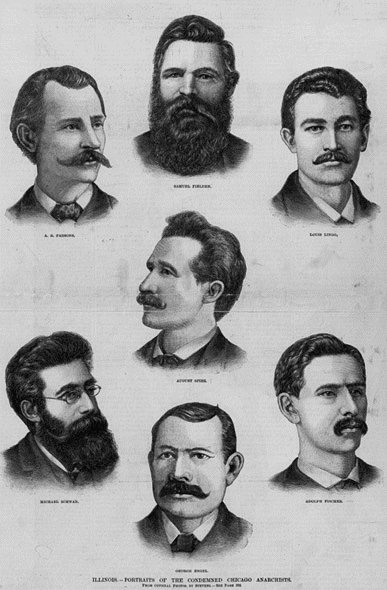
Portraits of the seven condemned anarchist (Frank Leslie's Illustrated)
Work began on an appeal to the State Supreme Court of Illinois. The defense in its November 1886 arguments before the Supreme Court cited six principal reasons for overturning the Haymarket convictions: (1) that some of the instructions of the court, both given and refused, were in error; (2) that some of the remarks of the court were sufficiently improper to be considered erroneous; (3) that errors obtained in connection with the impaneling of the jury; (4) that the closing argument of the State's Attorney appealed unduly to passion and prejudice; (5) that the State's theory of conspiracy, upon which the whole case rested, was untenable; and (6) that illegally obtained evidence had been introduced against the defendants. On September 14, 1887, the Court issued its decision rejecting each of the defense objections and upholding the convictions. The defendants appealed again to the United States Supreme Court. The Court, in an opinion by Chief Justice Waite on October 27, refused the writ of error contending that the defendants were denied "due process" under the fourth and sixth amendments. The Court ruled that their were no substantial federal questions presented in the case.
A last-ditch clemency effort garnered 100,000 signatures from American citizens. Writers including William Dean Howells, George Bernard Shaw and Oscar Wilde voiced criticism of the trial and urged mercy. The head of Chicago bar, a former Illinois U. S. Senator and various Chicago civic leaders urged the governor to grant at least some of the condemned men clemency. Hundreds of telegrams--on both sides of the issue--poured daily into the office of Governor Richard Oglesby in early November 1887. The job of reviewing an 8,000-page trial record overwhelmed the governor. After listening to final pleas on November 10, Governor Oglesby announced his decision: the sentences of Fielden and Schwab, who had requested commutation in writing, would be reduced to life in prison; the others, who had not made such a request, would die as scheduled.
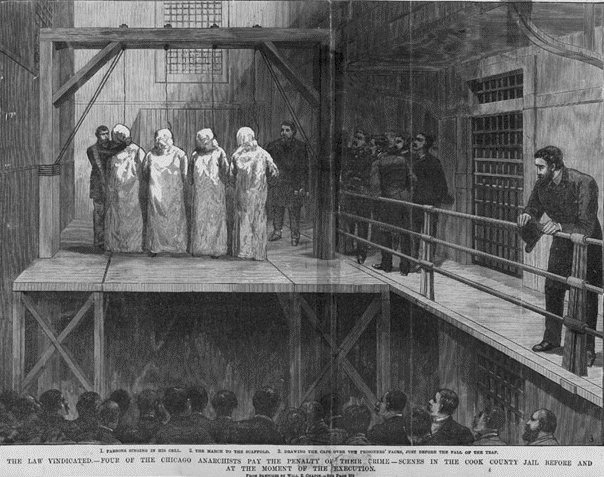
Execution Day: "The Law is Vindicated"
On the morning of Friday, November 11, 1887, dozens of armed police officers surrounded the jail. Shortly before 11:00, 250 reporters and other selected witnesses were ushered into a corridor in back of the courthouse. At noon, the four (Lingg had committed suicide the day before by lighting dynamite held in his mouth) condemned men marched in white robes toward the raised gallows that had been constructed the previous night. Engel, Fischer, Spies, and Parsons took their places in a line behind their respective nooses. The crowd watched quietly as guards fastened straps around the prisoners' ankles, nooses around necks, and shrouds over heads. The executioner lifted the axe that would cut the cord tripping all four trapdoors.
Behind the shrouds came voices. Spies could be heard saying, "The time will come when our silence will be more powerful than the voices you strangle today." Fisher announced, "This is the happiest day of my life!" Engel shouted "Long live anarchy!" Parsons was still speaking--"Harken to the voice of the people"--when the axe swung, the trapdoors opened, and the four men fell to their dooms.
The Haymarket Trial changed the course of lives and American political history. In Rochester, New York, a 17-year-old immigrant named Emma Goldman read the news from Chicago. She said what she called the "martyr's ordeal" implanted "something new and wonderful in my soul." She called the execution date the date of her "spiritual birth." In Chicago, Mary Harris Jones, a widowed dressmaker, declared that the executed defendants were soldiers who sacrificed their lives for workers. Mother Jones, as she came to be called, later referred to the Haymarket trial as the the "days of martyrs and saints." In Rebel Creek, Nevada, a young Bill Haywood called the Chicago trial the turning point of his life. Haywood would go on to found the IWW, the Industrial Workers of the World.
But the trial also set back the cause of workers' rights. Samuel Gompers, head of the new American Federation of Labor, said the bomb thrown at Haymarket not only killed policemen, it also killed the eight-hour movement. Also, rights workers previously enjoyed--like the right to hold rallies in public streets--came to an end in many American cities. The nation headed into an era of industrial violence and union busting.
Neebe, Schwab and Fielden served six years of their sentences before being pardoned in 1893 by Governor John P. Altgeld, elected with labor backing, who sacrificed a promising political career to right what he viewed as a judicial wrong.
The Haymarket trial was a key event in the history of free speech in America. It led to a far less tolerant approach to extreme opinions. The trial reminds us that the First Amendment, in the nineteenth century, amounted to just words on paper--and was not a real source of protection for ideas the public deemed dangerous. It would be another half century before the Supreme Court breathed real life into the First Amendment.
Principal sources for this commentary include Death in the Haymarket (2006) by James Green
and The Haymarket Tragedy (1984) by Paul Avrich.

